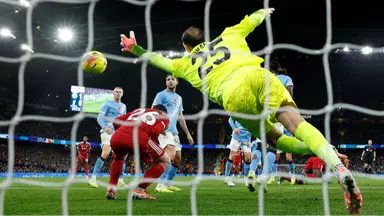Premier League Releases Full VAR Audio of Virgil van Dijk’s Disallowed Goal: A Detailed Breakdown

In one of the most talked-about moments of the Premier League season so far, Liverpool defender Virgil van Dijk had a goal disallowed during his team’s clash with Manchester City, igniting a storm of debate among fans, pundits, and officials alike. On Sunday, Liverpool faced Manchester City at the Etihad Stadium in what many described as a high-octane battle between two of English football’s premier sides. While City ultimately secured a commanding 3-0 victory, much of the post-match discourse focused not on the scoreline but on a single first-half incident: Van Dijk’s towering header that was controversially ruled out by the match officials.
In the days following the match, the Premier League released the full audio recording from the Video Assistant Referee (VAR) review that led to the disallowing of Van Dijk’s goal. The release comes in the wake of Liverpool formally raising concerns about the decision, prompting renewed scrutiny of how VAR is applied in high-stakes situations. This article delves into the incident, the reactions, the VAR process, and the broader implications for refereeing in English football
The pivotal moment occurred during the first half of the game. Liverpool had managed to create a dangerous attacking opportunity, with Virgil van Dijk positioning himself perfectly to meet a cross in the penalty area. As the ball arced towards him, Van Dijk leapt powerfully and headed it past Manchester City goalkeeper Gianluigi Donnarumma, sending the ball into the net. For a split second, it seemed that Liverpool had broken the deadlock.
However, the referee, Chris Kavanagh, and his team of officials immediately raised their concerns about Andy Robertson, the Liverpool left-back, who was nearby at the time. The decision hinged on whether Robertson had interfered with play, specifically whether his movement obstructed Donnarumma’s line of vision, thereby affecting the goalkeeper’s ability to make a save. After a VAR review, the goal was ultimately ruled out.
Liverpool, however, felt the decision was unjust. The club argued that Robertson had actively ducked out of the way to avoid contacting the ball and had not interfered with Donnarumma in any meaningful way. Senior figures at the club were particularly critical of the ruling, suggesting that the officials had misapplied the VAR protocol and that the usual checks and balances had not been followed adequately
Following the controversial decision, Liverpool formally contacted the Professional Game Match Officials Limited (PGMOL), the organization responsible for overseeing refereeing in English professional football. The club sought clarification and raised concerns about the disallowed goal.
In their complaint, Liverpool emphasized several points:
1.Robertson’s Position: The club maintained that Robertson had moved intentionally to avoid being in the way, and therefore did not constitute a player “interfering with play” under the Laws of the Game.
2. Goalkeeper Impediment: Liverpool challenged the notion that Donnarumma’s view or ability to save the ball had been impacted by Robertson’s actions. The club argued that there was no evidence to suggest the goalkeeper was genuinely obstructed.
3.VAR Protocol Adherenc: The club questioned whether all the standard VAR procedures had been followed. Typically, the VAR review involves a detailed check of the on-field incident, consideration of the relevant laws, and a collaborative decision-making process to determine if the original ruling was “clear and obvious.” Liverpool suggested that this process may not have been fully executed.
The complaint set the stage for an unprecedented level of transparency. In response, the Premier League released the full audio recording of the VAR review, allowing fans, analysts, and pundits to hear exactly what was discussed in the referee’s decision-making process
The audio, released as part of the Match Officials “Mic’d Up” series, provides a unique glimpse into the deliberations between the on-field officials and the VAR team. The key participants included:
The sequence of discussion began with assistant referee Stuart Burt pointing out Robertson’s proximity to Donnarumma. He described Robertson as being “in the line of vision, right in front of the keeper,” noting that he had “ducked under the ball” and was “very close” to the goalkeeper. Burt stated, “I think he’s line of vision. I think he’s (Donnarumma) been impacted, mate.
Chris Kavanagh, the referee, initially confirmed the offside call. Michael Oliver, the VAR official, then began a detailed check of the on-field decision, carefully evaluating Robertson’s positioning and movement. Tim Wood concurred with the initial assessment, noting that Robertson’s actions constituted a “clear, obvious action which clearly impacts on the goalkeeper
Ultimately, the VAR team confirmed the on-field decision, and Van Dijk’s goal was disallowed. Michael Oliver stated: “Chris, it’s Michael. Confirming the on-field decision of offside against Andy Robertson. He is in an offside position, very close to the goalkeeper and makes an obvious movement directly in front of him. Check complete, offside.”
Howard Webb, the PGMOL Chief Refereeing Officer, publicly defended the decision, providing insight into the reasoning behind it. He acknowledged that it was a “huge decision in a big game,” but emphasized that the officials’ judgment was based on poximity and timing.
Webb explained that Robertson’s movement, though subtle, occurred just three yards from the goal in the six-yard box—a highly sensitive area where even minor interference can affect the goalkeeper’s ability to save a shot. Webb stated:
“The officials have to make a judgment, did that clear action impact on the goalkeeper and his ability to save the ball? That’s where the subjectivity comes into play. They looked at that action so close to the goalkeeper and formed that opinion. I know that’s not a view held by everybody but it’s not unreasonable to understand why [the officials] would form that conclusion when the player is so close to the goalkeeper, the ball is coming right towards him and he has to duck to get out of the way.”
Webb further clarified the VAR’s role in such scenarios, noting that the VAR only intervenes if the on-field decision is “clearly and obviously wrong.” In this instance, Webb asserted that the officials’ judgment fell within the bounds of reasonableness, and there was insufficient evidence to overturn the call
The disallowed goal quickly became a focal point for pundits and football analysts. Former players, coaches, and commentators offered a wide range of opinions, reflecting the subjective nature of VAR decisions in high-pressure situations
Some pundits sided with Liverpool, arguing that the interpretation of “interfering with play” was overly strict in this case. They suggested that Robertson’s conscious effort to move out of the way demonstrated that he was not obstructing Donnarumma. Critics also questioned whether VAR had followed all procedural steps before confirming the decision.
Others defended the ruling, noting that VAR is designed to assist referees with subjective judgment calls and that proximity in the six-yard box can justify such decisions. These analysts emphasized that officials must make instantaneous judgments based on limited visual evidence, and that VAR exists to confirm that the on-field assessment is not clearly wrong
This incident is far from the first time VAR has sparked debate in English football. Since its introduction in the Premier League, VAR has been involved in numerous controversial moments, including disallowed goals, penalty decisions, and red card calls.
One of the recurring criticisms of VAR is its subjective nature. While technology allows referees to review footage from multiple angles, the interpretation of what constitutes interference, handball, or offside remains a human judgment. Critics argue that this subjectivity undermines the goal of VAR, which is supposed to reduce clear errors.
Liverpool’s complaint and the subsequent release of audio may signal a shift towards greater transparency, allowing fans and clubs to better understand the reasoning behind contentious decisions.
For Liverpool, the disallowed goal was particularly significant. At the time of the incident, the game was still tightly contested. Scoring could have altered the dynamics of the match, potentially shifting momentum in Liverpool’s favor. While City ultimately dominated the game, the psychological impact of the decision was felt among players, staff, and supporters.
For Manchester City, the ruling reinforced the importance of defensive organization and goalkeeper awareness. Donnarumma’s positioning and reaction remained critical, even in a situation where an offside call was involved. The incident highlights how small margins and split-second decisions can influence outcomes at the highest leve
This event has reignited the ongoing debate about VAR in football. Key questions include:
Consistency : Are similar incidents being judged consistently across different games?
Transparency: Should VAR audio be routinely released to ensure accountability?
Subjectivity: Can technology truly eliminate human judgment, or will subjective decisions always remain?
Fans and analysts argue that increased transparency, such as publishing full VAR audio, can enhance trust in referees. By providing insights into the decision-making process, stakeholders can better appreciate the complexity of officiating in high-pressure situations.
Virgil van Dijk’s disallowed goal against Manchester City remains one of the most debated moments of the Premier League season. While the Premier League and PGMOL have defended the decision, Liverpool’s complaint underscores the ongoing challenges of applying VAR in a way that balances accuracy, consistency, and fairness.
The release of full VAR audio provides an unprecedented look behind the curtain, illustrating both the precision and subjectivity involved in top-level refereeing. For fans, it offers clarity; for players and clubs, it highlights the fine margins that can determine the outcome of a match.
Ultimately, this incident serves as a reminder that football, like life, is often a game of interpretation, split-second judgments, and passionate debate. While technology can assist, human judgment remains at the heart of the sport, ensuring that every controversial moment continues to spark conversation, analysis, and, occasionally, controversy. Topics Covered: Premier League, Liverpool, Manchester City, Virgil van Dijk, Andy Robertson, Gianluigi Donnarumma, VAR, PGMOL, Howard Webb, Chris Kavanagh, Michael Oliver, Tim















